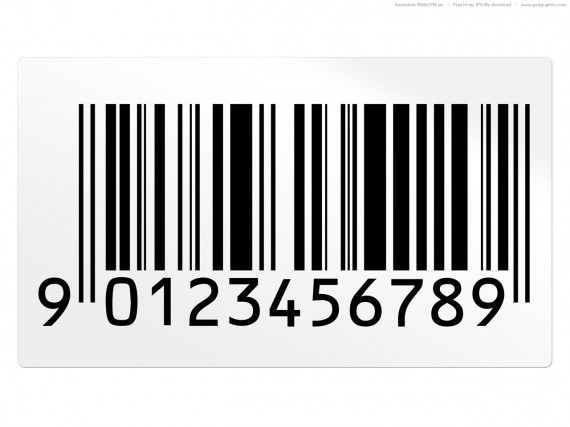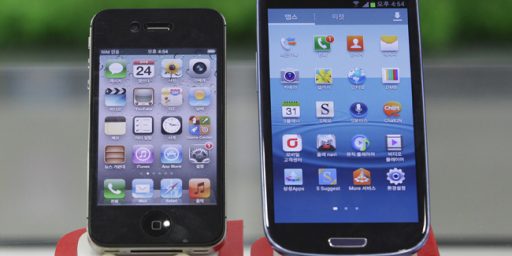Co-Inventor Of The Bar Code Dies At 91
One of the men responsible for something that has become a ubiquitous part of modern life has passed away:
N. Joseph Woodland, who six decades ago drew a set of lines in the sand and in the process conceived the modern bar code, died on Sunday at his home in Edgewater, N.J. He was 91.
His daughter Susan Woodland confirmed the death.
A retired mechanical engineer, Mr. Woodland was a graduate student when he and a classmate, Bernard Silver, created a technology — based on a printed series of wide and narrow striations — that encoded consumer-product information for optical scanning.
Their idea, developed in the late 1940s and patented 60 years ago this fall, turned out to be ahead of its time. But it would ultimately give rise to the universal product code, or U.P.C., as the staggeringly prevalent rectangular bar code is officially known.
The code now adorns tens of millions of different items, scanned in retail establishments around the world at the rate of more than five billion a day.
The bar code would never have developed as it did without a chain of events noteworthy even in the annals of invention etiology:
Had Mr. Woodland not been a Boy Scout, had he not logged hours on the beach and had his father not been quite so afraid of organized crime, the code would very likely not have been invented in the form it was, if at all.
(…)
An early idea of theirs, which involved printing product information in fluorescent ink and reading it with ultraviolet light, proved unworkable.
But Mr. Woodland, convinced that a solution was close at hand, quit graduate school to devote himself to the problem. He holed up at his grandparents’ home in Miami Beach, where he spent the winter of 1948-49 in a chair in the sand, thinking.
To represent information visually, he realized, he would need a code. The only code he knew was the one he had learned in the Boy Scouts.
What would happen, Mr. Woodland wondered one day, if Morse code, with its elegant simplicity and limitless combinatorial potential, were adapted graphically? He began trailing his fingers idly through the sand.
“What I’m going to tell you sounds like a fairy tale,” Mr. Woodland told Smithsonian magazine in 1999. “I poked my four fingers into the sand and for whatever reason — I didn’t know — I pulled my hand toward me and drew four lines. I said: ‘Golly! Now I have four lines, and they could be wide lines and narrow lines instead of dots and dashes.’ ”
That transformative sweep was merely the beginning. “Only seconds later,” Mr. Woodland continued, “I took my four fingers — they were still in the sand — and I swept them around into a full circle.”
Mr. Woodland favored the circular pattern for its omnidirectionality: a checkout clerk, he reasoned, could scan a product without regard for its orientation.
On Oct. 7, 1952, Mr. Woodland and Mr. Silver were awarded United States patent 2,612,994 for their invention — a variegated bull’s-eye of wide and narrow bands — on which they had bestowed the unromantic name “Classifying Apparatus and Method.”
But that method, which depended on an immense scanner equipped with a 500-watt light, was expensive and unwieldy, and it languished for years.
The two men eventually sold their patent to Philco for $15,000 — all they ever made from their invention.
By the time the patent expired at the end of the 1960s, Mr. Woodland was on the staff of I.B.M., where he worked from 1951 until his retirement in 1987.
Over time, laser scanning technology and the advent of the microprocessor made the bar code viable. In the early 1970s, an I.B.M. colleague, George J. Laurer, designed the familiar black-and-white rectangle, based on the Woodland-Silver model and drawing on Mr. Woodland’s considerable input.
Thanks largely to the work of Alan Haberman, a supermarket executive who helped select and popularize the rectangular bar code and who died in 2011, it was adopted as the industry standard in 1973.
Mr. Woodland, who earned a master’s in mechanical engineering from Syracuse University in the 1950s, received the National Medal of Technology and Innovation in 1992. Last year, he was inducted into the National Inventors Hall of Fame. (Mr. Silver, who died in 1963, was inducted posthumously along with him.)
Not a famous man, but one who came up with an idea that has changed the way we do business.






Hopefully the maker of the QR code will die next.
There was a “Mad” magazine cover which said “We hope this cover screws up every register in the country…because now we have to include this yecch-y code on the front!!” Next to the new, permanent UPC code was a gigantic, blown-up version of the code.
Oh, and btw, George H.W. Bush HAD seen them before that campaign stop in 1988.
------
=====
=====
------
======
======
------